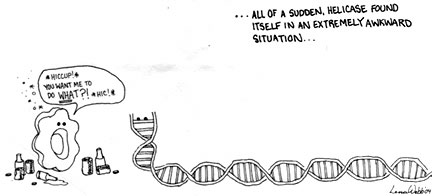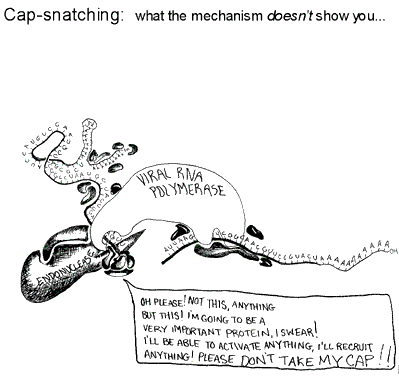OF COURSE PROTEINS TALK TO EACH OTHER
My first serious molecular biology course in college was entitled “DNA and Chromatin Structure” and there were only four students enrolled. While we were expected to take our best stabs at entertaining graduate level ideas, the class size made things inherently informal. One of our most common mistakes was the casual anthropomorphizing of molecular machinery.
“But the protein wouldn’t want to interact with the binding site because…” or “RNA polymerase acts like a drunken sailor during the process of transcription—halting, pausing, falling off…” We knew that these complex molecules weren’t capable of harboring a yen for anything at all, but these imagined personas and traits were comforting things to write in the margin of a Nature paper due for presentation the following week.
For me, however, this forbidden level of molecular paling around became more than just a security blanket—it turned into one of my favorite pastimes. I began to illustrate the imagined cellular conversations between the proteins that we had so frequently described as “talking to one another.”

The example above represents one of my most well-received attempts at molecular humor. At least half of those entertained [50% of 2 is 1] claim that “it’s the eyes” that do it. I still think it’s really the empty Coors cans.
So if proteins can talk, which they clearly can and do, they can also scream. Molecular biologists are forever fawning over “mechanistic coupling” and “cooperative binding,” but it’s also quite easy to imagine the cellular milieu as a terrifying and violent place. Acetyl groups being wrenched off by deacetylases, proteins being ground up into peptide offal by the proteasome, deformed mRNA transcripts being sent to processing bodies where certain degradation awaits them— If Dante had access to a microscope, he may have been inspired to add a tenth circle of Hell with an approximate diameter of 10 microns.
It was during a Virology class where we were discussing host cell exploitation that I again heard those tiny voices, only this time I imagined them crying out for help.

After my professor explained to us that Influenza virus carries with it a polymerase capable of literally decapitating host cell mRNA transcripts, thus rendering them untranslatable and useless, he stopped and asked “Lena—do you have a question?” The slack-jawed look of horror on my face must have been mistaken for confusion, and the rest of the class turned to look at me. “No, no, I’m fine—I get it.” I replied.
And I did get it. I was finally coming to the conclusion that anthropomorphizing macromolecules is wrong, and perhaps a tad bit unhealthy. It is going to be difficult enough to determine how the entire population of a cell interacts without trying to take into consideration individual “personalities” and “motives.”
It would, however, make for some great movies. Tiny movies. Tiny enough to be microinjected into cells, just in case they ever get bored in there…